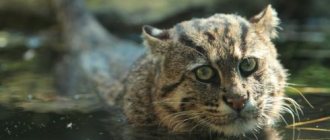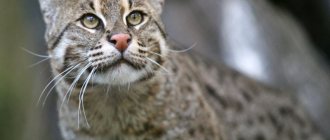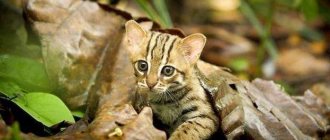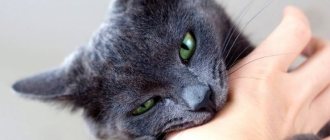Captivity
Charismatic appearance and funny habits attract more and more attention to the civet cat. Many exotic lovers began to express a desire to keep the animal as a pet after the website of the famous fishing cat named John Davis, who lived with his owners for three years in the most ordinary apartment in the city of Krasnoyarsk, was widely promoted on the Internet.
This is the most famous fishing cat from Krasnoyarsk - John Davis
Taming
A wild animal will never be able to become a “plasticine” pet, and the Krasnoyarsk story is a clear confirmation of this. But if it so happens that you want to take a risk and repeat the attempt to tame an Asian cat, do not get a male, there is practically no chance of reaching an amicable agreement with him. Females of this species are much more docile.
Taming begins at an early age, no later than three months, until the kitten is able to naturally perceive a person as a member of its family. Contact must be established gradually, and in no case should you frighten the animal or put pressure on it. At the first stage, you should ensure that the cub learns to take pieces of food from your hands without any problems.
Taming and feeding a wild kitten will be simplified by your domestic cat
Aviary keeping is not suitable - if you want to get a truly tame pet, you will have to pay maximum attention to it and spend a lot of time communicating together. The fishing cat is very jealous and remembers insults well - this should also be taken into account. He may well find a common language with other cats and even with the dogs with whom he grew up in the house, but on occasion he will not deny himself the pleasure of hunting someone whom he considers weaker than himself.
The character of the “tame cat” is very complex
These animals are extremely intelligent and quick-witted, they very quickly perceive the rules of behavior in captivity and the hierarchy of their new pack. Usually, a fishing cat chooses only one owner, whom he considers the main one, and agrees to obey him. This stubborn cunning man can significantly ignore the demands of other family members
But he can show serious jealousy, protecting the attention of his beloved owner from other household members - but such moments are sometimes fraught with serious danger
Content nuances
The main problems when keeping a viverrid cat in captivity can arise when the animal enters puberty. Zoologists recommend castrating your pet in a timely manner; this will help stop manifestations of aggression and make the cat more manageable. But such measures will also not provide guarantees of unclouded coexistence of wild animals on the same territory as humans.
The fishing cat adapts well to the zoo environment
A cramped cage is disastrous for an inquisitive, active and mobile wild cat - it needs a lot of space and impressions: sufficient territory for walking and several different shelters. If there are good living conditions and adequate nutrition, a pair of fishing cats will quite possibly be concerned about procreation and bring forth charming offspring.
These animals have a very strong immune system and good resistance to infectious diseases. However, before changing teeth, it is necessary to vaccinate the kitten twice with a complex vaccine and then repeat the vaccination annually. There are cases where Asian cats lived in well-fed and prosperous conditions of captivity for up to twenty years.
The charming appearance of the civet cat is deceptive, and it is better to observe its behavior and habits from a distance. Do not experiment with keeping wild animals in your home, do not try to turn them into harmless fluffies. Nature cannot be fooled, and the habits of a wayward savage can take over, creating a serious danger for all the inhabitants of your home.
Is it possible to keep a viverrid cat at home?
Fishermen are predators living in the wild. Their behavior is unpredictable, and their habits do not correspond to the behavior of a cute pet. In many countries around the world, captive breeding of these animals is prohibited, due to the pugnacious nature and rarity of the breed. However, exotic lovers are not deterred by the fact that the predator can grow uncontrollable and cause a lot of problems for the owners.
Breeders do not miss the opportunity to make money on this. They open civet cat nurseries, offering everyone who wants to have exotic animals at home.
Place in an apartment or an enclosure?
In the wild, these predators avoid humans, but do not show aggression. Taken home very young, they adapt well to the home lifestyle and can become loyal friends. It is better to choose females that cause fewer problems in adulthood. Male animals can mark territory and be jealous of strangers, protecting their owner from them with their claws and teeth.
Raising a kitten requires a special approach and time, and it must begin from the moment the baby appears in the house. You need to hand feed him, pet him, and communicate with him a lot. It is advisable for the pet to live with family members, and not in a separate enclosure. In this case, he will be more sociable and tame, and will not remain an independent wild predator.
It should be borne in mind that an exotic pet will not deny itself the pleasure of feasting on those who are weaker than it, so you should not leave it alone with other pets. It should also be remembered that the natural instincts of an adult can take precedence over upbringing at any moment. Then the animal will become dangerous to people.
Best articles: Causes of forest fires, their impact on the environment and humans
How to walk a cat?
Viverrid cats are freedom-loving animals that need space. They are cramped even in a country house; they need daily two-hour walks. They walk this unusual pet on a harness, allowing you to explore the secluded corners of the territory. Animals do not tolerate cold well; for walks in the autumn-winter period they will have to be dressed warmly.
Anglers should be taught the litter box and the rules of behavior in the house from childhood, stopping unwanted actions with a stern voice (in extreme cases, you can use an air pump to scare them away). The pet must be rewarded for its success with affection and treats. During games, you need to be careful not to allow the animal to bite or scratch, otherwise the game will quickly develop into a hunt for him, and he will perceive the owner as prey. If the cat has seriously misbehaved, you can lock him alone in the room for a while.
What to feed your unusual pet?
Animal nutrition should be as close as possible to their natural diet. They should be able to catch a fish, gut a game, catch a frog. The energy requirement of domestic pets is less than that of their wild relatives, but the animal's daily diet should consist of 1–1.5 kg of poultry or fish. Once a week you can arrange a half-starvation day by offering chicken or quail eggs, fresh herbs. After consulting with your veterinarian, you should choose vitamin and mineral supplements.
Health and hygiene
Domestic fishing cats live about 12–15 years. Caring for him should be as thorough as for cats of other breeds. Animals have their nails trimmed and their ears cleaned. You should be accustomed to such manipulations immediately, since in adulthood the animal can get scared and injure the owner. The fur of fishermen practically does not shed, which simplifies its maintenance.
Domestic cats of other breeds are reluctant to go into the water. However, for a fisherman cat who loves to swim, it is advisable to organize a small pool in the garden. From time to time it is worth introducing live fish there and bringing frogs to the animal. In this case, the pet will be able to realize its hunting instinct. When keeping a predator in an apartment, a bathtub will help out, where the civet cat can splash around. To make it interesting for him, you can throw toy fish into the water.
By nature, predators have good health and strong immunity. However, they need preventive vaccinations. The first vaccination should be carried out before teeth change, and then repeated annually. At 2–3 years old, cats begin to mark their territory, so if there is no desire to use them for breeding, the pet must be neutered no later than 8 months.
Description of cats of the viverrid fishing cat breed
The size of this large and rare animal is quite large, although it is smaller than, for example, a panther or a leopard. But, with a weight equal to fifteen kilograms for a mature cat, and ten kilograms for a cat, fishing cats can be considered full-fledged large predators.
Appearance:
- The length of the animal’s body, including the tail, is more than one meter, and the tail, which is the same in thickness from base to end, accounts for approximately one-fourth of the total length of the cat’s body. One has only to look at the massive and strong body of a fishing cat, and it is immediately clear that this is a true hunter;
- large and wide head, elongated muzzle. The ears are somewhat rounded. Large eyes and a wary gaze, however, it also reflects the confidence of a civet cat. These cats have naturally powerful and strong limbs, so they can successfully defeat even larger enemies;
- The coat is olive-gray in color, with black spots and stripes that are placed in a row. Matte fur helps the cat to camouflage perfectly in the bushes. There are also black stripes on the tail, and they are also present on the animal’s forehead and neck;
- The way these cats differ from cats of other breeds is their uniquely shaped nose. They do not have a bridge of the nose, and the nose itself is very large and wide. No other cat has such a wide nose, no matter how big or small it is. This structure allows the civet cat to swim and dive well. He is able to hold his breath, taking a deep breath without taking water into his nose.
Cost of a fishing kitten
To purchase this unique cat, which is a couple of times larger than a regular domestic cat, you will need to obtain special permission. This is due to the fact that the civet fishing cat is in the Red Book. As for the cost of a kitten of this breed, it reaches 300 thousand rubles. Not every Russian can afford to buy an animal for such a price.
But it is important to understand that the purchase is only a tiny part of the amount that will have to be spent on the maintenance of this exotic animal
Do you know that…
1.6 kilograms – the weight of a sperm whale tooth
Site search
Let's get acquainted
Economic significance for humans
Positive
These cats are hunted for various aspects of trade, however it remains unclear which parts of the cat's body are valuable for trade. Fishing cats are also important for educational and research purposes.
Negative
The civet fishing cat hunts domestic animals. However, research has shown that pets are not the primary source of food.
Fishing cat, speckled cat, or fish cat
The fishing cat, speckled cat, or fish cat (Prionailurus viverrinus) is a wild cat of Southeast Asia, distinguished by its ability to fish and swim well. The species is closely related to the Far Eastern cat and is similar to it, but is larger in size.
The fishing cat lives in tropical and subtropical regions of southeast Asia: in the south and east of India, Indochina, Ceylon, Sumatra, Java. These animals are closely associated with wetlands, and are commonly found in swamps and wetlands, oxbow lakes, reed beds, and tidal creeks of mangrove forests.
As representatives of the cat family, speckled cats with their behavior refute the popular belief that felines do not like water. As the name suggests, fishing cats are not only not afraid of water, but also depend entirely on it, being excellent swimmers.
However, speckled cats are often incorrectly attributed as physical adaptations to aquatic activities. While webbed feet were previously noted to be a feature of these felines, the partial membrane between the toes is actually no more developed than in other wild or domestic cats. But the structure of the paws of speckled cats really does not allow them to completely hide their claws, which is a huge plus for aquatic hunting.
But the double layer of fur, which is the owner of fishing cats, is indeed not found in all felines. It is this layer that prevents speckled cats from getting wet to the skin during water hunting. The weight of an adult animal is from 11 to 15 kg (males), 6-7 kg (females), with a body length of 96.5-119.3 cm, height at the withers of 38.1-40.6 cm.
Fishing cats have a stocky body and relatively short legs, a short thick tail, a wide head and a short muzzle. The fur is light or dark gray in color with black stripes along the neck and face, dark brown spots in the form of stripes and spots on the body, and a number of incomplete circular rings on the tail.
As the name suggests, fish are the main prey of fishing cats. A one-year study of a family of speckled cats in Keoladeo National Park, India, found that fish made up about three-quarters of the diet, with the rest consisting of birds, insects and small rodents. On occasion, shellfish, reptiles and amphibians are also eaten by these animals. Fish cats hunt along the edges of bodies of water, snatching prey from the water, and sometimes dive if the fish or other prey is far from the shore. Sometimes fishing cats use deceptive hunting tactics: quickly touching the surface of the water with their paws, they create ripples, and thereby mislead the aquatic inhabitants of the reservoir, after which it is not difficult for them, with the help of their clawed paws and excellent reaction, to catch fish or other inhabitants of the reservoir.
Fishing cats can mate at any time of the year, but most often breeding occurs between January and February. The female builds a den in a secluded place, and reed thickets are excellent for this purpose. After a pregnancy that lasts 63-70 days, the female gives birth to two to three kittens. Babies at birth weigh about 170 g, and are able to actively move at the age of one month. They begin playing in water and eating solid food at about two months, and are fully weaned at six months. At approximately eight and a half months, kittens are already the size of an adult animal, milk teeth change to permanent ones at eleven months, and speckled cats become sexually mature at 1.5 years of age.
Viverrid fishing cat (Prionailurus viverrinus)
- a species of medium-sized wild cat from the cat family
(Felidae)
, genus oriental cats
(Prionailurus)
.
Trowel.zh.rf
Want to know everything
But we have already studied a lot of wild cats! How can you not remember? I’m telling you exactly what it was, look here:
There is such an amazing exotic cat - the Asian fish cat, also known as the fishing cat, or vivverina. This cat lives and feeds near water. She is not afraid of water, swims well and is said to be able to dive to catch fish.
Felis viverrinus belongs to the class of mammals, order - carnivores, family - felines; lives in Southeast Asia in small areas of India, China, Vietnam, Thailand, Sumatra and Java.
The cat got its name because of its amazing ability to hunt in water. The uniqueness of the fishing cat is that all representatives of the cat family do not like and are afraid of water, but for the Asian fishing cat, water is its native element.
This cat lives and feeds near water. She is not afraid of water, swims well and is said to be able to dive to catch fish. Loves wet, marshy places near rivers and streams.
An adult male weighs from 11 to 15 kg, females are much smaller - 6-7 kg. The body length of an adult cat is 95.0-120.0 cm, the height at the withers is 38.0-40.0 cm. It has a strong build and great strength. The muzzle is short and wide; the ears are small, round, set low on the sides of the head; The jaw is round, the lower one is very strong, equipped with sharp teeth. The animal's head is round, set on a short neck. The fishing cat has short legs and a short and thick tail.
The cat's color is grayish-brown with speckled black, and there are black spots behind the ears. On the upper part of the body, the spots are located along the body, on the lower part - across. The end of the tail is dark. The forehead is decorated with longitudinal stripes or rows of spots.
There are membranes between the toes of the front paws that help the cat catch fish. During a hunt, a cat sits on the river bank and patiently waits for a fish to swim past. The fishing cat will never miss its prey: it hits the fish with its clawed paw and firmly places it on its claws as if on hooks. Sometimes this cat even dives to the bottom of the river for prey. Fish is a favorite food for this cat, but the cat does not disdain other foods: it also eats frogs, snakes, snails, birds, small mammals and carrion.
Fish cats breed all year round. Pregnancy in a female lasts 2-2.5 months, after which she usually gives birth to 2-3 kittens. After 9 months, kittens become adults. Males kept in captivity help the female care for the offspring, but how they behave in the wild is unknown.
The cat eats mainly fish. It also hunts toads, frogs, crustaceans, snakes, small mammals and birds. They can attack poultry, dogs, goats, and calves. It catches fish during daylight hours; at dusk and at night it can hunt for other prey. While fishing, a fishing cat sits on the bank of a stream or river and waits for fish to swim past, and when it does, it sharply hits the prey with its clawed paw.
The civet cat fisher can climb trees, but he does it reluctantly and does not like it. Loves to walk in shallow water and is a good swimmer. When swimming, it uses its short tail as a rudder. The fishing cat, like many cats, leads a solitary lifestyle. Each animal has its own individual territory.
Fishing cats have a reputation for being bullies and fighters, but they try to avoid meeting people. A case is described when one wiverina dispersed a pack of dogs. In some regions of Asia, there is a myth that a fish cat stole a newborn child from Singapore, however, this case is not documented. However, an interesting true fact is that a male fish cat kept in the zoo, a very large specimen, broke out of his cage and, entering the leopard’s cage, killed him.
Fishing cats caught at a young age are well tamed and become attached to people. The local population persecutes those cats who steal their poultry and devastate their fish stocks. The meat and skin of wiverin are used by Aboriginal people in folk medicine to prepare medicines.
There are two recognized species of fishing cat. The species found in Sri Lanka and along the entire coast of South and Southeast Asia down to Malacca and Sumatra are larger animals. Smaller representatives of the species live in Java and Bali.
The fishing cat is a rare animal listed in the International Red Book and the CITES Convention (Appendix II). The total population size does not exceed 10,000 mature individuals. Threats to the species: destruction of wetlands, poaching, pesticide pollution of rice fields. There are two recognized species of fishing cat (Felis viverrina), which differ in size: C. v. viverrinus - India, southern eastern Asia and Sumatra, S. v. risophores - Java and Bali.
Character, temperament
The civet cat is mainly nocturnal and always lives near water. It can climb trees, but very rarely does this; it mainly wanders in shallow water in search of prey.
Very smart and cunning, luring the victim, it hits the water with its paw. When there are ripples on the surface of a reservoir, underwater inhabitants think that this is the movement of insects and rise to the top. An adult is capable of swimming long distances, up to several kilometers.
Sexually mature females and males lead a solitary lifestyle, carefully marking their habitat with their own scent, secretions and claw marks on trees and protecting their territory. So, a female is able to control from 6 to 8 square meters. km., and the male from 16 to 22.
When in danger, adult animals make a characteristic sound reminiscent of laughter.
The speckled cat is available for socialization. The behavior of a civet cat when living next to a person is described below.
Lifestyle
Fish cats are nocturnal and crepuscular animals. At night they actively hunt, and during the daytime they sleep, hiding in dense thickets. Each animal, which has its own individual territory and jealously guards it, lives and hunts separately.
Viverrid cats climb trees quite well, but they do it very reluctantly. They feel much more confident in the water. Being natural fishermen, civet cats are excellent swimmers and, in pursuit of prey, can cover considerable distances and dive to great depths.
Fishing tactics can be extremely varied:
- Cats can simply walk in shallow water, catching small animals that may be ungainly (snails, crustaceans, frogs).
- Using its webbed paws like a scoop, the fisherman cat can throw its prey ashore.
- Most often, the fish cat prefers to ambush fish. Hiding on the shore, she waits until the intended victim gets as close as possible, after which she quickly rushes into the water. A clever hunter is rarely left without a catch.
- In an effort to feast on fish, a civet cat can show cunning. Standing motionless in the water, he, imitating the movements of insects, lightly touches its surface with his paw. The fish, attracted by this movement, swims closer and ends up in the tenacious paws of the successful fisherman.
- A fish cat can also pursue prey at depth, pressing its ears tightly to its head to protect them from water.
A wild speckled cat, leading a solitary lifestyle and possessing an independent character, always avoids meeting with a person, but for a relative who accidentally enters its territory, it will arrange an indispensable showdown. Civet cats are recognized bullies who are not afraid to engage in single combat either with an opponent twice their size or with a whole pack of dogs.
Appearance
External resemblance to the family of viverrid mammals is reflected in the Latin name of the species (viverridae), and is expressed in a variegated pattern against a background of olive-brown color, identical to the body shape and short legs. The distant relationship of these animals, dating back to the last era of the Paleogene period, cannot be ruled out.
In size, the civet cat is almost twice as large as an ordinary domestic cat.
- The length of the body reaches a meter, the height at the withers is 38–41 cm.
- The weight of an adult male is 11 - 15 kg, females - 6 - 7 kg.
- The tail is thick at the base, thin at the end, and not long.
- The physique is strong, squat, clumsy at first glance, but the animal’s movements reveal strength, swiftness and a kind of grace.
- The massive head almost merges with the body due to the short neck.
- The facial part of the skull is wide, the jaws are powerful, with sharp long fangs.
- A large nose with a wide, shortened bridge of the nose stands out on the muzzle in a pale pink color, surrounded on both sides by sparse fan-shaped mustaches.
- The ears are small, semicircular in shape, with white edges inside and black behind.
- The eyes are round, yellow-green. Pupils in the form of vertical lentils.
- The paws are short, with webs between the toes; the claws are not fully retracted.
- The coat is hard, coarse, short, with a matte sheen.
- The main tone of the coat color is dominated by olive and light gray shades. The paws, sides and tail are covered with small, chaotically located black spots, and there are several ring-shaped stripes at the tip of the tail. On the head and back, the spots merge into longitudinal stripes. There are white markings around the eyes and behind the ears.
Scientific classification
- Kingdom: Animalia (animals)
- Phylum: Chordata
- Class: Mammalia (mammals)
- Order: Carnivora (predatory)
- Family: Felidae (felines)
- Genus: Prionailurus (oriental cats)
- Species: Prionailurus viverrinus (fishing cat)
The fishing cat received its specific name “viverrinus” due to its external resemblance to civets (viverra), although its closest relative is the Far Eastern cat.
Other names : fish cat, speckled cat, civet fishing cat.
Scientists have described two subspecies of fishing cats:
- Prionailurus viverrinus viverrinus – India, Sri Lanka, Pakistan, Bangladesh, Indochina, Nepal and possibly Bhutan;
- Prionailurus viverrinus rhizophoreus – Bali and Java.
Features of behavior
If you live in a large private house with a pool or pond nearby, then this is the most interesting breed to observe. Fishing cats are excellent swimmers, and they hunt with amazing skill. They have quite a lot of techniques; they can wait on the shore, and when they see a fish approaching, they can attack it from the shore. Cats have fun searching for frogs and snails in shallow water. Even more interesting is the technique of fishing at depth. The paws of a swimming cat create small ripples that attract underwater inhabitants. Seeing prey, it dives after it to any depth.
These animals are big fighters. There is a known case when a civet cat kept in a zoo killed a leopard. In the wild they usually avoid humans. Raised by humans, with a large territory for outdoor games and a reservoir for hunting, animals can be quite affectionate, but a maturing uncastrated male can claim his rights to the status of owner. It's not easy to argue with him.
Diet
Although their diet consists primarily of fish, they are considered generalists . On land they hunt some birds, insects, mice and other rodents, snakes, lizards and frogs. In addition to fish, mollusks, crayfish, crabs and snails are caught in the water. They have also been observed eating carcasses killed by a tiger or other large mammal.
Fishing cats sometimes kill domestic animals, including chickens, geese, guinea fowl, turkeys, goats, sheep, calves, rabbits, and fish from private ponds. A year-long dung analysis study in India found that grass was present in their diet in all months except August, during the monsoon season.
Photo: SCAR
Speckled cats are often seen wading and swimming in shallow water while hunting a variety of aquatic prey. But more often, fishing cats hunt fish while completely submerged in water. When catching fish, they stand at the edge of the reservoir, submerge their heads under the water and toss or remove the prey with their paws.
The tactic of luring fish closer to the limit of reach by "tapping" the surface of the water, imitating the movement of an insect, has also been recorded. One report described speckled cats catching waterfowl by grabbing their legs from below.
Description of the fishing cat
Like most wild predators, the appearance, habits and character of a fishing cat are entirely dependent on natural conditions. After all, hunting for prey is a process on which the life of a cat and its offspring depends, so it is necessary to have a coloring that is consistent with the general nature and a strong body.
The animal swims and dives well in search of prey
External data
An adult civet fishing cat weighs up to 15 kg. The body can be from 96 to 120 cm in length, and the height at the withers can be from 38 to 40 cm. Moreover, cats are twice lighter and smaller than males.
The animals have a strong physique, characteristic of all representatives of the cat family. At the same time, the following external signs are considered to be the distinctive features of a fishing cat:
- short skull shape;
- practically absent bridge of the nose;
- round and very powerful jaw;
- ears are small and round in shape;
- short thick neck;
- short legs;
- shortened tail length;
- Webbing on the front paws between the toes.
The color allows the cat to remain invisible against the backdrop of wild nature.
The color of the civet fishing cat is standard: the skin is grayish-brown with black spots. The fur is thick, short, and has waterproof properties. The skin has a matte finish, which allows the angler to blend into the environment.
On land, the cat moves somewhat awkwardly, trying to cling to the ground. The tail is used for balancing while walking and swimming. It has the same thickness throughout its entire length, and in all cats it is necessarily striped.
Character
The civet cat has the typical character of a predator. Typically, the female occupies a territory of up to 8 km². This space is enough for her not only to hunt, but also to feel safe for her cubs. An adult male fishing cat defends his rights to a much larger area - about 22 km².
Among the natives, fishermen have long been known as bullies and brawlers, although they avoid meeting people. Cats conflict not only with other animals, but also with each other if a stranger has violated the boundaries of someone’s territory. This is perhaps the most important quality in their character.
Since zoological observations of fishing cats are very rare, and they are practically not kept in captivity, little is also known about the nature of the animals. The fisherman is very handsome and unusual in appearance, but his attractive appearance is in no way associated with the temperament of a serious killer cat.
The image of a “cute cat” does not fit in with the character of a cunning and strong predator
Habitat
Viverrid fishing cats can be found in the tropics or subtropics. Therefore, they are accustomed to hot climates and have never seen snow. The optimal temperature for these cats is 25–30 degrees Celsius. Animals live in dense forests near swamps, rivers and lakes, which greatly alleviates the effects of heat. Geographically, the range of fishermen is the countries of Southeast Asia:
- India;
- Indochina;
- Ceylon;
- Sumatra;
- Java.
At the same time, cats from the island of Java are significantly inferior in size to their relatives from the continent.
The dense, humid forests of Asia are the favorite habitat of fishing cats.
Nutrition
The civet fishing cat knows how to swim well - the waterproof undercoat and membranes on the front legs help him in this. Thanks to this skill, they build their own line of hunting: they wait for prey on the shore, and then rush at the prey in one jump. Cats can also walk in shallow water in search of small animals: frogs, crabs or snails.
Hunting for fish requires more skill, so the cat can not only swim, but also dive to depths. Fish constitutes the main diet. Cats are very cunning and lure fish from the depths to shallow water with light strikes of their paws on the water. The fish, feeling the vibrations of the water, swims towards the blow in the hope that it is an insect that is drowning, but ends up in the tenacious paws of the cat.
In “hungry” years, the fisherman does not even disdain carrion, catching snakes and insects. In extremely rare cases, a fishing cat may attack livestock (for example, catch a lamb or kid).
For its food, the fishing cat uses almost all types of small animals, insects and fish.
Reproduction
Viverrid cats do not have a specific mating season - they can breed all year round. This is explained by their habitat - it is always warm in tropical and subtropical Asian forests.
Puberty occurs in the second or third year of life. Pregnancy lasts approximately 63–70 days, after which the female gives birth to two or three cubs. Growing up takes 9 months, after which the kittens can live independently away from their parents.
It takes 9 months for civet kittens to grow up.
Life of wild forest cats in nature
Forest cats have a wide distribution area and are found in Europe, Africa, along the shores of the Sea of Japan, in the jungles of India, the steppes of Turkestan, the mountains of Scotland and the Caucasus.
You can still find a lot of wild cats in the Scottish mountains
These animals prefer to settle in deep forests, where people rarely visit. Therefore, it is rare to discover the wild ancestors of domestic purrs. Mountain clefts and deserted shores of reservoirs become favorite places for forest cats to live.
These small predators can choose abandoned fox or badger holes, empty tree hollows, and even uninhabited nests of large wading birds as shelter.
The territory occupied by one animal is about 2 hectares in size. Boundaries are marked with the help of odorous anal secretion, with which males carefully irrigate trees and shrubs. An irreconcilable war is waged for each plot, especially during the mating season.
It is also interesting that wild cats do not like areas where there is a lot of snow. After all, under the abundant snow cover, it is difficult for small animals to get food. Therefore, in especially snowy winters, purrs walking on their own can be found near a person’s home. This is how forest cats try to survive, because people always have food.
Peculiarities of behavior of forest cats
Since these representatives of the cat family are wild predators, the cats have a corresponding disposition. Animals love freedom and fiercely defend their independence.
Forest cats are skilled and dexterous hunters
Wild forest cats are loners, leading a secretive lifestyle. The animals quickly and easily evade pursuit, hiding in gorges or on treetops. They lead a nocturnal lifestyle, but do not shy away from hunting in the daytime.
Any small animal that can be caught can serve as prey for forest purrs. These can be rats, nutria, as well as hares or squirrels. A wild cat will not refuse to catch waterfowl, fish, and even crayfish. And in arid regions, insects, snakes and lizards become victims of tailed animals.
The method of attack of forest cats is similar to the hunting methods of other representatives of the species - predators catch prey in a jump, sometimes reaching a length of three to five meters.
To hear even a “word” from a wild forest hunter, you need to greatly anger the animal. And then the animal will make hissing, howling or even whistling sounds. And the meowing typical of cats can only be heard during mating dances and the search for a partner.
Procreation issues
For most of the year, wild forest cats prefer to avoid the company of even their own kind. However, with the onset of cold weather in January, males begin to gather in small groups and look for females for mating until the end of March.
Wild forest cats give birth to up to five kittens in one litter
If two cats develop a liking for the same cat, fights with characteristic fights and warlike cries arise between the furry “knights.”
It also happens that forest males choose domestic females as partners, and then the latter give birth to wild and wayward kittens.
Pregnancy in wild forest cats lasts 62–67 days, after which blind kittens are born. The eyes open only 9–12 days after birth. One litter usually produces five cubs, but there may also be one kitten. Or, on the contrary, the brood turns out to be numerous - up to seven heads.
Shortly before giving birth, the female finds a secluded place from which she makes a safe den. Kittens will grow up in this shelter until they are four months old. The mother cat feeds her cubs with breast milk for the same amount of time.
The level of safety decreases when the grown offspring begins to leave the den on their own - at one and a half to two months of age. And then martens and foxes will pose a threat to the life of the young animals.
At two months, young forest seals begin to go hunting, accompanied by a cat, and at five months they enter adulthood. Males begin to explore new lands, while females remain in the maternal area.
Forest purrs live for quite a long time - up to 15 years. However, young animals often die before reaching 10 years of age.
And if there are no threats in the form of large predators, then life expectancy increases up to 30 years of age. Such situations arise, among other things, when animals enter a person’s home.
Reproduction of fishing cats
Although mating in fishing cats can occur at any time of the year, the peak of sexual activity occurs in late January - February. Like many other cat species, the female fish cat builds a den for future offspring. It makes shelter in hard-to-reach places such as reed beds.
Males kept in captivity help females care for their offspring, but it is unknown how “daddies” behave in the wild.
Pregnancy lasts 65–70 days, after which the female produces a litter consisting of 2–3 cubs. Like many other felines, fishing cat cubs are born blind and helpless. The weight of a newborn is only about 170 g.
After a month, the cubs not only see and hear well, but also become active. From the age of 60 days, they already begin to switch from mother’s milk to solid food, but young animals stop feeding entirely on milk only at the age of 6 months. Kittens reach adult size at the eighth month of life. At the beginning of the first year of life in young cats, baby teeth are replaced by primary teeth. Speckled cats reach sexual maturity at the age of one and a half years.
If you find an error, please select a piece of text and press Ctrl+Enter.
Reproduction and care of offspring
Little is known about the reproduction of wild civet cats; the animal leads a very secretive lifestyle in nature. In captivity, the fishing civet cat can breed all year round. The relative peak of activity is observed at the end of February, beginning of March.
Pregnancy in a female lasts about 2 - 2.5 months (63 - 70 days). The male does not abandon the female and helps her prepare for the upcoming birth. Parents look for a secluded place, arrange and insulate the den.
As a rule, two or three kittens are born. The weight of the cub does not exceed 170 grams. The main food for offspring in the first three months is mother's milk. From the age of two months, parents accustom their babies to solid food. Once they reach nine months, kittens grow to adult size and can take care of themselves. The final formation of a sexually mature individual occurs by 15 months.
In the wild, the predator avoids humans, but does not show aggression without a special reason. A cat caught as a kitten can be tamed and get used to people. Quite often, the fishing cat is found in zoos in Europe. The animal is kept in specially equipped enclosures, has access to an artificial reservoir and living conditions close to its natural habitat.
The animal adapts well to a domestic lifestyle and, if you follow the breeders’ recommendations, can become a loving and devoted friend. It is better to choose a female. When she grows up, there will be less hassle and problems with her. Males that have reached sexual maturity begin to mark their territory and jealously protect their owners from strangers with the help of their claws and teeth. The consequences of such actions are dangerous and fraught with dire consequences.
Raising a kitten requires some effort and a special approach. The animal has a complex, conflicting character, however, it is very smart and intelligent. It is better to adopt a kitten from a nursery at two months of age. In order for the baby to quickly get used to the new home, he is hand-fed and surrounded with care and affection.
They are taught to use the tray and commands from childhood. Prohibitions are indicated in a calm and confident tone. Be sure to praise when everything is done correctly. The cat has an ambivalent attitude towards other pets, and gets used to them only when he grows up with them.
An adult pet grows to a respectable size, but at heart it remains the same little kitten. Uses proven play techniques - bites, grabs arms and legs, may accidentally scratch or miscalculate the force of the bite. At best, after such games the owner will experience very painful sensations.
Before buying an animal, it is necessary to study not only the external description of the breed, but also the habits of the potential pet. The fishing cat's greatest passion is fishing. It’s cruel to deprive him of such pleasure. In an apartment, you can periodically set up a “pond” right in the bathtub and put floating toys into it. In a country house, you can equip a swimming pool for an artificial pond. The cat will be happy to swim there, and if you add live fish, it will also hunt.
The diet consists of fish and lean deli meats. The daily food intake is 1.5 kg. Vitamin preparations and various mineral supplements are added to food.
Appearance and habits
A large predator is endowed with the following external features:
- The body is strong.
- A large, broad head with a round jaw that is very similar to that of a pit bull.
- The color is from gray-olive to gray-brown with black spots that are located throughout the body and stripes on the muzzle, starting above the eyes and extending to the back of the head.
- The bridge of the nose is practically absent, as if flattened and at the same time quite wide. No cat breed has such an unusual shape. The structural feature of the bridge of the nose helps the cat dive and swim in water.
- The ears are small, flattened, and sit low. Behind the ears there are white eye spots, which are especially noticeable when demonstrating discontent and aggression.
- The legs are short, but very strong. The toes of the front paws have webs that help them swim and fish.
- The fur is layered: the first layer consists of short, hard hair, which has such a dense structure that water and cold do not penetrate through; the second layer is short, coarse hair with undercoat, forming a characteristic pattern. The wool is matte, which makes it easy to camouflage in natural conditions.
- The tail is short, constituting a third of the body length, and has the same thickness throughout.
Similar article: How to choose a cool Sphynx and name the kitten
The largest individual has a mass of 15 kg, height at the withers reaches half a meter. Males significantly exceed females in weight and size (almost twice). The civet cat's greatest passion is hunting fish. During the day, the animal is able to eat about 1.5 kg of fish.
To summarize, let us note once again the special differences between the fishing cat and other felines:
- special structure of the bridge of the nose;
- webbed front feet;
- pressing ears tightly when diving;
- the cat's ability to swim and dive.
Exterior data
Fishing cats are quite large animals: the size of a dog, about 40 centimeters at the withers, weighing up to 15 kg (females are smaller, about 7 kg).
The length of the body is about a meter. Fit and muscular, they have the grace and swiftness of a leopard and great strength. Their muzzle is short and wide, which makes them even more impressive. The ears are small and round, pressed to the head - demonstrating aggression. The jaws are very strong, which is why these animals are called the pit bulls of the cat world.
The head is large, almost merges with the body due to the short neck. The legs and tail are short and thick. The fur is short and coarse, waterproof. Fishing cats have another remarkable feature: they have membranes between their paws that help them hunt in the water. They prevent you from retracting your claws, but they help a lot when fishing.
Reproduction
There is little information available about the breeding of angler's civet cats. Fishing cats breed once a year, during January and February. They were also spotted breeding in June. The gestational period is 63 days, after which 1 to 4 kittens are born. Cubs weigh between 100 and 173 grams at birth and gain approximately 11 grams per day. On the 16th day their eyes open. Meat is introduced into the kittens' diet on the 53rd day, and weaning from mother's milk occurs at 4-6 months. At 9 months, young individuals reach the size of an adult cat, and gain independence at 10 months. They probably become sexually mature shortly after this.
It has been observed that males in captivity help females care for their offspring and take part in raising kittens. It is unclear whether civet cats replicate this behavior in the wild.
[edit] Behavior
Unlike many felines, fishing cats are very good swimmers. In search of food, they fish not only near the shores of reservoirs, but also at great depths. They also tend to play with their prey in shallow water.
The home territories of fish cats cover an area of 4-8 km² for females and approximately 22 km² for males.
Communication between animals occurs through various chemical and acoustic signals.
Based on the way they feed, fishing cats can be characterized as a piscivorous species. The basis of their diet is fish and shellfish. Observations show that fish cats can eat dogs, sheep and calves. In 1987, a cat was spotted eating a dead cow. Analysis of 144 scat samples revealed that 109 contained fish, 39 contained birds, 31 contained grass, 18 contained insects, 13 contained rodents and 11 contained a mixture of lizards, snakes, shellfish, rabbits and cows.
Fishing cats have no natural enemies other than humans.
Range of miniature predators
African wild cats live in the desert regions of South Africa. The animals have chosen a number of countries: Botswana, Angola, Namibia, Zimbabwe and South Africa. Scientists distinguish two varieties of black-footed cats. The more numerous of them are light in color and live in Namibia. The second group is much smaller in number and its representatives live in Botswana.
In a number of countries, rare wild cats are protected and hunting them is prohibited. Thus, Botswana and South Africa are concerned about preserving the population. In these countries, work is underway to combat poachers. In addition, animals often die from dog attacks and under the wheels of cars. Human activity also has a negative impact on the population size.
Appearance and features
A fishing cat has the following main characteristics of its body:
- The color of the short, tight-fitting fur is beige-sand with dark specks of a fairly large size - the so-called speckled. Thanks to this coloring, the animal is successfully camouflaged in dry and green vegetation. And this helps him prove himself as a successful hunter;
- the body is quite developed and muscular, which allows it to be a very successful predator and obtain food for itself, sometimes larger in size than the animal itself;
- The neck is short, powerful, ensuring a secure position of the head. It is precisely this muscularity of this part of the body that makes it possible to successfully fish out and drag large-sized prey;
- The muzzle is large with small, widely set ears, which the cat keeps tightly pressed to the head. The part of the mouth is clearly defined - it is massive, giving the cat a certain specificity;
- the muzzle is not elongated;
- the tail is quite short and thick at the same time. The animal controls it for balance, especially when climbing trees. The fur on it is no more fluffy than on the rest of the animal’s body.
Additional Information! If we talk about hunting instincts and the ability of the animal to feed itself, it is worth noting that it has fairly long and sharp claws, as well as powerful teeth and jaws - they play the role of a kind of gear with the help of which the cat catches quite large fish compared to its own size. He can also carry a heavy load over a long distance.
History of the discovery of the variety
Fishing cats have been known to the indigenous populations of many Asian countries since ancient times. These animals preferred to hide in the thickets of the tropical jungle during the day, so for a long time there were only legends about the ghost cat.
During the development of new territories, extensive deforestation and drainage of wetlands began. Viverrid cats had to adapt to new living conditions; they became more noticeable to people and, unfortunately, became objects of hunting.
Hunters continue to catch civet kittens for sale, despite the fact that in most countries in the animal's natural range, these actions are punishable by law.
The name of the species was given by the English zoologist and writer Edward Turner Bennett in 1833, having described in detail the morphology and color of the cat, which in India was called “fishing cat”.
In 1958, the name Prionailurus was proposed to the new species by the Russian researcher and naturalist Nikolai Severtsev as a common name for the spotted cat species of Asia, and the name Felis viverrinus rhizophoreus was given by the Dutch scientist Henri Jacob Victor Sodi in 1936. He described in detail the Viverrid cat caught on the coast of West Java. This individual has a slightly shorter skull than specimens previously found in Thailand.
The name Speckled is associated with the fur pattern - the cat's entire body is covered with dark specks.
Viverrid means similar to the tropical predatory mammal civet or civet, mainly due to its secretive lifestyle. The cat is called a fisherman due to its preferences in hunting, fishing and nutrition.
The names of the predator in local dialects are also interesting. In Assamese it is Meseka (fish), in Bengali it is Maha-bagrol or Bagh-Dasha. Maha means fish and Bagha means tiger. In Hindi, the name of the Fishing Cat sounds like Ban-Biral, in Telugu - Bavuru-pilly (wild cat), in Sinhala - Handun Divya, in Thai - Sea-Pla (fish tiger). In Myanmar, this predator is called Kuanga-ta-nga. "Kuanga" means "cat" and "ta-nga" means "fisherman".
[edit] Distribution and protection
The range of fishing cats covers scattered areas of the Indomalayan biogeographical zone. They are common in peninsular India, Sri Lanka, Malaysia, Thailand, Pakistan and Java. They inhabit mainly wetlands, as well as dense forest areas adjacent to rivers, jungle areas, reed and bush thickets. They live at altitudes of up to 2100 meters above sea level.
A major threat to fishing cats is the destruction of their habitat, especially wetlands. For example, in Sri Lanka, it has been documented that various factors such as land reclamation, untreated water discharge, clearing of natural vegetation and general environmental pollution are responsible for habitat loss. In addition to habitat loss, fish cats are suffering from overfishing caused by destructive fishing practices, as well as poaching for food and harvesting of various body parts for medicine.
Fishing cats are listed on Appendix II of CITES. They are protected by national legislation throughout most of their range. Hunting of fish cats is prohibited in Bangladesh, Cambodia, China, India, Indonesia, Myanmar, Nepal, Pakistan, Thailand and Sri Lanka. Regulated hunting is practiced in Laos. In Bhutan and Vietnam there is no protection outside protected areas. The conservation of this species depends primarily on adequate protection of Asian wetlands, as well as on the prevention of poaching.
The International Union for Conservation of Nature considers the fishing cat as an endangered species.
The civet fishing cat is native to Southeast Asia.
The very name of the breed says that civet cats live in close proximity to water, where they can always find enough food for themselves. Experts divide representatives of this breed into two types. They are practically the same in appearance, but the size of the fishing cats that live on the coast of Southeast and South Asia, including the island of Sumatra, is much larger than their relatives living on the islands of Java and Bali.
These large cats choose wet places located in the jungle as their place of residence. They feel great in mangrove swamps found in coastal areas, most often on island territories. They do not like to climb trees, as their body is very massive. The favorite pastime of the fishing cat is hunting for fish.
During the hunt, they wander through shallow water, and with a quick movement of their paws, equipped with sharp claws of substantial size, they pick up unwary fish. When hunting in water, fishing cats can also use cunning - keeping their bodies completely still, they lightly touch the surface of the water, imitating the movement of insects. Fish attracted by this movement become easy prey for the civet cat.
The fishing cat feels great on the water and in its deep places. The peculiarity of the structure of the paws, which have membranes between the claws, allows it to easily swim long distances. They say that civet cats, in pursuit of prey, even dive to shallow depths, and to prevent water from getting into their ears, they press them tightly to their heads.
Habitat of the Margay cat
Margays inhabit almost all warm jungle areas of America (Panama, Ecuador, Guyana, Uruguay, Peru, Argentina). Most long-tailed margays live in central America.
Most margays live in different areas of Mexico, Ecuador and Brazil
The role of the long-tailed cat in the ecosystem
Due to the rarity of the species, it is impossible to reliably establish the role of margay in the ecosystem. However, like any other predator, the long-tailed cat affects the population of small mammals. Margai will not be able to destroy large numbers, for example, of squirrels, since the predator is quite loyal to its prey. A cat can survive without encountering squirrels at all.
The main role of margay in the ecosystem is to exterminate rodents
Upbringing
Forget about brute force. An adult meter-long animal with huge claws can easily defeat a person. From childhood, accustom him to the fact that if it is impossible, then completely and forever. The prohibition should be indicated in a calm, confident tone. An air pump can be used to punish systematic offenses. A blast of air + a verbal command will be remembered much better.
Don't play with your kitten using your own hands and feet as toys! Growing up, cats remain just as playful, but become much stronger. A playful bite on the leg will become quite painful. Buy a variety of toys for joint leisure.
This is a very smart breed. We train a fishing cat in almost the same way as a dog, so conduct regular training from an early age. A light collar should be put on your pet on the day of purchase, gradually replacing it with a more durable one. The same goes for litter box training. Do not punish the kitten for relieving itself in the wrong place, show it where it is necessary and praise it when it does everything correctly.











